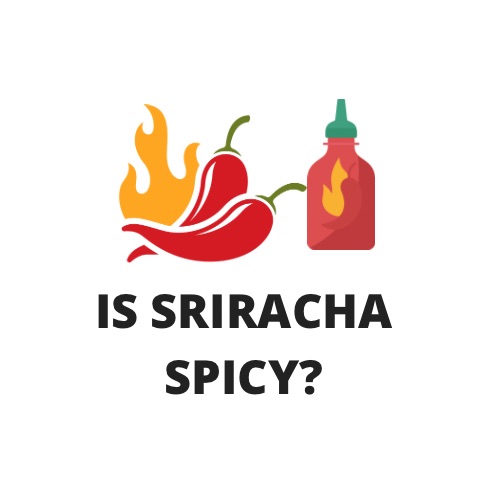We know that Sriracha is a hot sauce because it’s made from the paste of chili peppers mixed with other ingredients like vinegar, garlic, salt and sugar.
But how spicy is sriracha, really?
In this article, we’ll introduce you to the Scoville scale and explain how it works, which is necessary in order for us to be able to gauge exactly how spicy Sriracha hot sauce is, as well as how it compares to other hot sauces.
We will also discuss some of the factors that can affect the spiciness of sriracha, such as the brand of sriracha and the ripeness of the chili peppers.

How Spicy Is Sriracha? How Much Scoville Is Sriracha?
While the heat level of sriracha can actually fluctuate depending on the brand and type of chili peppers used, Sriracha generally falls in the low-medium spiciness category, scoring between 1,000 to 2,500 Scoville Heat Units (SHU) on the scoville scale.
The SHU is a standard measurement of the spicy heat sensation in chilies, reflecting their capsaicin content.
Capsaicin is the chemical responsible for that burning feeling in your mouth when eating hot peppers—it’s what gives those tiny fiery fruits their potent punch.
How does Sriracha measure up against other peppers and sauces on the Scoville scale?
Well, bell peppers don’t contain any heat at all.
Jalapeño peppers range from 2,500 to 8,000 SHU while Tabasco sauce measures from 2,500 to 5,000 SHU.
Serrano peppers can hit as high as 23,000 SHU and Cayenne peppers go even further at around 30,000 to 50,000 SHU.
The Habanero pepper ranges from a whopping 100,000 to 350,000 SHU!
Ghost peppers go even beyond that with an impressive range of 855,000 to over a million SHUs!
And we dare not forget one of the world’s hottest pepper – Carolina Reaper!
This flaming fruit can rate anywhere from an outrageous 1,569,300 to a volcanic-like intensity reaching up to an astronomical figure of over two million SHUs.
Does Sriracha Get Hotter Over Time?
No, the fiery potency of sriracha does not amplify with age.
If anything, it’s more inclined to lose some of its spicy kick rather than maintain it as the peppers age and lose their heat-inducing chemicals.
This reduction in heat is particularly noticeable when Sriracha isn’t stored properly.
Did Sriracha Get Less Spicy? Did The Manufacturers Make Sriracha Less Spicy Than Before?
In all honesty, yes!
And the answer, interestingly enough, points to a change in the core ingredient: the type of chili pepper used.
The original recipe for Huy Fong’s Sriracha called for Serrano peppers, which pack a punchy Scoville heat rating range from 10,000 to 25,000.
However, due to harvesting challenges, the company switched to using red jalapeño chili peppers instead.
These have a significantly lower Scoville rating, only hitting between 4,000 to 8,500, which has effectively made the beloved Sriracha less spicy.
Another noteworthy shift involves Huy Fong changing its main pepper supplier in 2017 from Underwood Ranches after a partnership of 28 years. This too could have had an impact on the distinctive spice ratio.
Additionally, it’s worth noting that spiciness can be perceived differently depending on external factors related to plant growth that are beyond human control. So there can be some variations in your experience with its heat from bottle to bottle.
Finally, let’s not overlook our own taste buds’ adaptability.
Regular spice consumers often build up a tolerance over time to capsaicin, the compound responsible for making chilies hot, so what used to send you reaching for water might not elicit the same reaction today!
Which Sriracha Brand Is The Hottest? (Rank From Less Spicy To Spicy)
#7 Shark Brand Sriracha: Touting its roots in Si Racha, Thailand, Shark Brand offers an authentic take on Sriracha sauce crafted from red Thai chili peppers. It impresses with a thin texture and vinegary flavor, while delivering a gentle spice level ranging from 500 to 1,000 Scoville Heat Units (SHU).
#6 Huy Fong Foods Sriracha: Recognized by its green cap and rooster logo, this popular US brand serves up a heat level that’s low-medium, ranging from 1,000 to 2,500 SHU.
#5 Kikkoman Sriracha: A somewhat favorite across many American households, Kikkoman provides another low-medium heat option scoring between 1,000 to 2,500 SHU. But it just edges Huy Fong Foods Sriracha for us.
#4 Tabasco Sriracha Sauce: Opt for the marriage of two iconic hot flavors, Sriracha and Tabasco, for a spicier kick at about 3,000 Scoville units.
#3 Underwood Ranches Sriracha: At 3rd position is former Huy Fong Foods jalapeño supplier Underwood Ranches. Its medium spice level ranges between 2,500 to 5,000 SHU delivered in a thick sauce with a smoky-sweet flavor.
#2 Sky Valley Sriracha: The runner up for the species sriracha goes to sky valley. Dial up the heat with Sky Valley’s plant-based and gluten-free sauce made from organic ingredients. With its fiery flavor profile and medium-high spice intensity of 5,000 to 10,000 SHU—this one isn’t for the faint-hearted!
And drumroll please…
#1 Polar Sriracha Chili Sauce: Claiming the top spot for spiciest is another Thai original – Polar’s Sriracha Chili Sauce. Prepare for a high-heat adventure with this one as it ranks between a whopping 10‚000 to an intense 15‚000 SHUs!
Are All Sriracha Sauce Hot?
No, not all Sriracha sauces are hot, or designed to set your taste buds aflame.
As we’ve seen from our earlier ranking, the heat level of Sriracha varies greatly depending on the brand.
Take for example Shark Brand Sriracha, which offers a milder kick on the Scoville scale, compared to its hotter counterpart – Polar Brand.
The scale of heat primarily lies in the type of chili peppers used in the sauce.
Varieties like red jalapeños, Thai chilies or even potent ghost peppers can significantly sway the spiciness quotient of the sauce.
Moreover, other factors like varying amounts of sugar and vinegar also play a critical role in affecting the spiciness perception.
While sugar can balance out excessive heat by promoting a sweeter undertone, vinegar amplifies it by enhancing sharpness and tang.
Additionally, some brands may also incorporate unique ingredients like fish sauce, lime juice or herbs which helps to add depth, complexity and a whirlwind of flavors beyond just heat.

